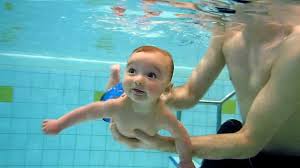 The diving reflex, is a set of physiological responses to immersion that overrides the basic homeostatic reflexes.
The diving reflex, is a set of physiological responses to immersion that overrides the basic homeostatic reflexes.
The DR optimizes respiration by preferentially distributing oxygen stores to the heart and brain, enabling submersion for an extended time.
The DR is exhibited in aquatic mammals, and exists as a lesser response in other animals, including human babies up to 6 months old and diving birds, such as ducks and penguins.
Adult humans generally exhibit a mild diving reflex response.
The diving reflex is triggered specifically by chilling and wetting the nostrils and face while breath-holding.
When the face is submerged in water and it fills the nostrils, sensory receptors sensitive to wetness within the nasal cavity and other areas of the face supplied by the fifth (V) cranial nerve (the trigeminal nerve) are activated.
These cranial nerves relay the sensory information to the brain.
The diving reflex is sustained via neural processing originating in the carotid chemoreceptors.
The diving reflex effects are on the cardiovascular system, with peripheral vasoconstriction, slowed heart rate, redirection of blood to the vital organs to conserve oxygen, release of red blood cells stored in the spleen, and, heart rhythm irregularities.
The tenth (X) cranial nerve, (vagus nerve) part of the autonomic nervous system produces bradycardia and other neural pathways elicit peripheral vasoconstriction, restricting blood from limbs and all organs to preserve blood and oxygen for the heart brain and lungs, concentrating flow in a heart–brain circuit and allowing the conservation of oxygen.
The DR is not employed when limbs are introduced to cold water.
Mild bradycardia is caused by holding one’s breath without submerging the face in water.
When breathing with the face submerged, the diving response increases proportionally to decreasing water temperature.
The greatest bradycardia effect occurs induced when a subject is holds their breath with their face wet.
Apnea with nostril and facial cooling are triggers of the DR.
Children tend to survive longer than adults when deprived of oxygen underwater: it may be a result of brain cooling similar to the protective effects seen in people treated with deep hypothermia.
During sustained breath-holding blood oxygen levels decline while carbon dioxide and acidity levels rise,and they act upon chemoreceptors located in the bilateral carotid bodies.
The carotid bodies, sensory organs, convey the chemical status of the circulating blood to brain centers regulating neural outputs to the heart and circulation.
The carotid bodies are essential for inregrating cardiovascular responses of the diving response: a chemoreflex characterized by the parasympathetic slowing effects on the heart and sympathetic vasoconstrictor effects on the vascular system.
Immersion diuresis occurs within a short period after immersion, resulting in plasma fluid losses.
Head-out immersion causes blood to shift from the limbs into the thorax.
Immersion results in a fluid shift from the extravascular tissues and the increased atrial volume results in a compensatory diuresis.
The plasma volume, stroke volume, and cardiac output are higher than normal during immersion.
The increased respiratory and cardiac workload causes increased blood flow to the cardiac and respiratory muscles with immersion.
Bradycardia reduces the overall cardiac output, particularly due to the diving reflex in breath-hold diving.
Bradycardia is the response to facial contact with cold water, with a rate slow down of ten to twenty-five percent.
During breath-holding there is reduced left ventricular contractility and diminished cardiac output: the slowing the heart rate reduces the cardiac oxygen consumption, and compensates for the hypertension due to vasoconstriction.
Breath-hold time is reduced when the whole body is exposed to cold water as the metabolic rate increases to compensate for accelerated heat loss even when the heart rate is significantly slowed.
The spleen contracts in response to lowered levels of oxygen and increased levels of carbon dioxide, releasing red blood cells and increasing the oxygen capacity of the blood.
Blood shift occurs when blood flow to the extremities is redistributed to the head and torso during a breath-hold dive.
Peripheral vasoconstriction occurs during submersion by resistance vessels limiting blood flow to muscles, skin, and viscera.
These regions are hypoxia-tolerant, preserving oxygenated blood for the heart, lungs, and brain.
The increased resistance to peripheral blood flow raises the blood pressure, but is compensated by bradycardia.
Blood pressure and bradycardia both are accentuated by cold water.
Cardiac arrhythmias are a commonly associated with the diving response.
The diving reflex, increases activity of the cardiac parasympathetic nervous system which regulates the bradycardia, but also is associated with ectopic beats,
Arrhythmias may enhanced by neural responses to face immersion in cold water, distension of the heart due to central blood shift, and the increasing resistance to left ventricular ejection by rising blood pressure.
Findings in the electrocardiogram during human breath-hold dives include ST depression, heightened T wave, and a positive U wave following the QRS complex.
There is also associated reduced left ventricular contractility and overall depressed cardiac function during a dive.
In well hydrated people immersion will cause diuresis and excretion of sodium and potassium.
Diuresis is reduced in dehydrated subjects, and in trained athletes in comparison with sedentary subjects.
Snorkel breathing is limited to shallow depths due to the effort required during inhalation to overcome the hydrostatic pressure on the chest.
Hydrostatic pressure on the surface of the body due to immersion in water causes negative pressure breathing which shifts blood into the intrathoracic circulation.
Facial immersion at the time of initiating breath-hold is a necessary factor for maximizing the diving reflex.
The activation of the diving reflex, which has 3 main properties:
bradycardia, peripheral vasoconstriction, and blood shift which occurs only during very deep dives that affects the thoracic cavity.
